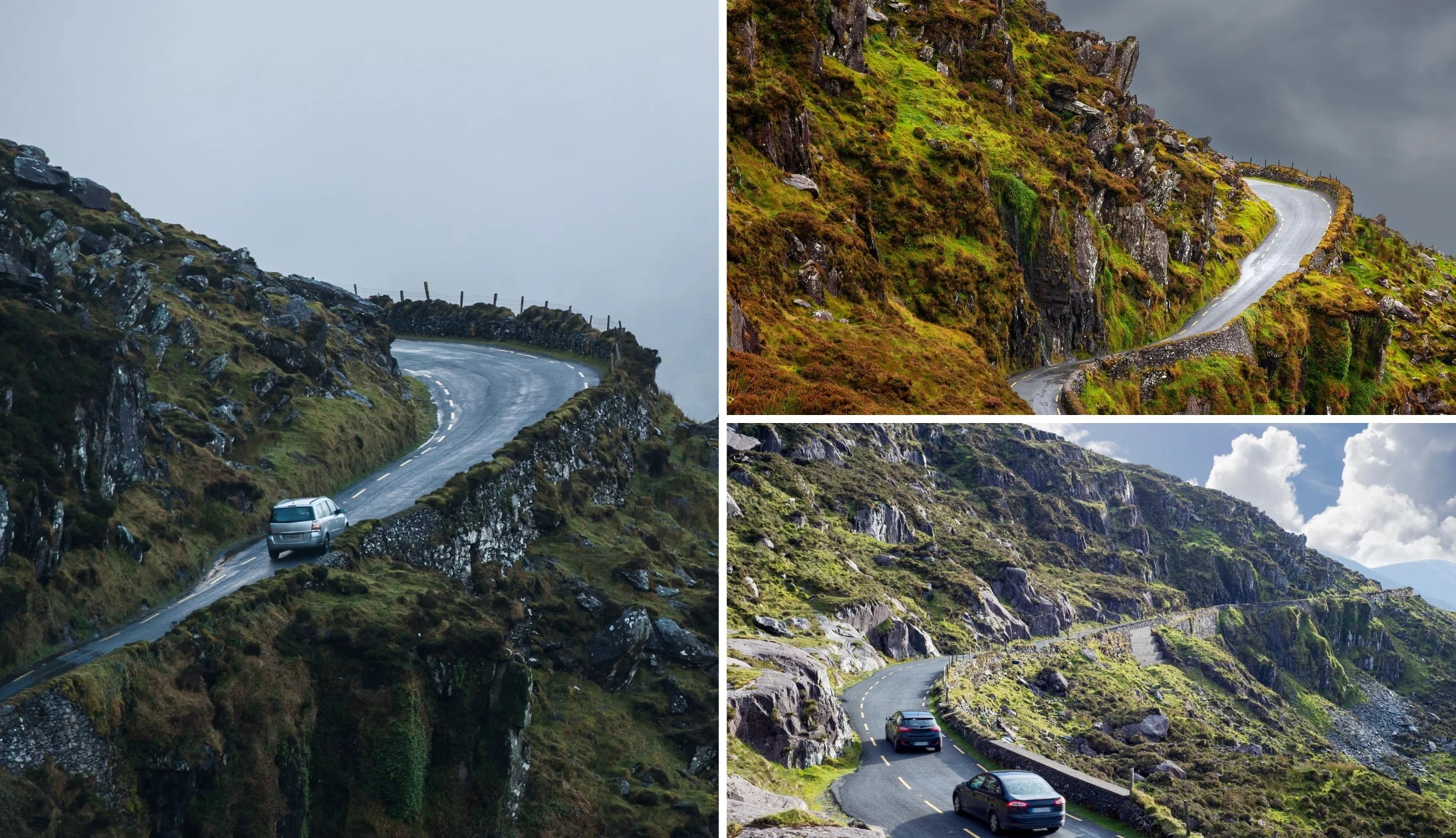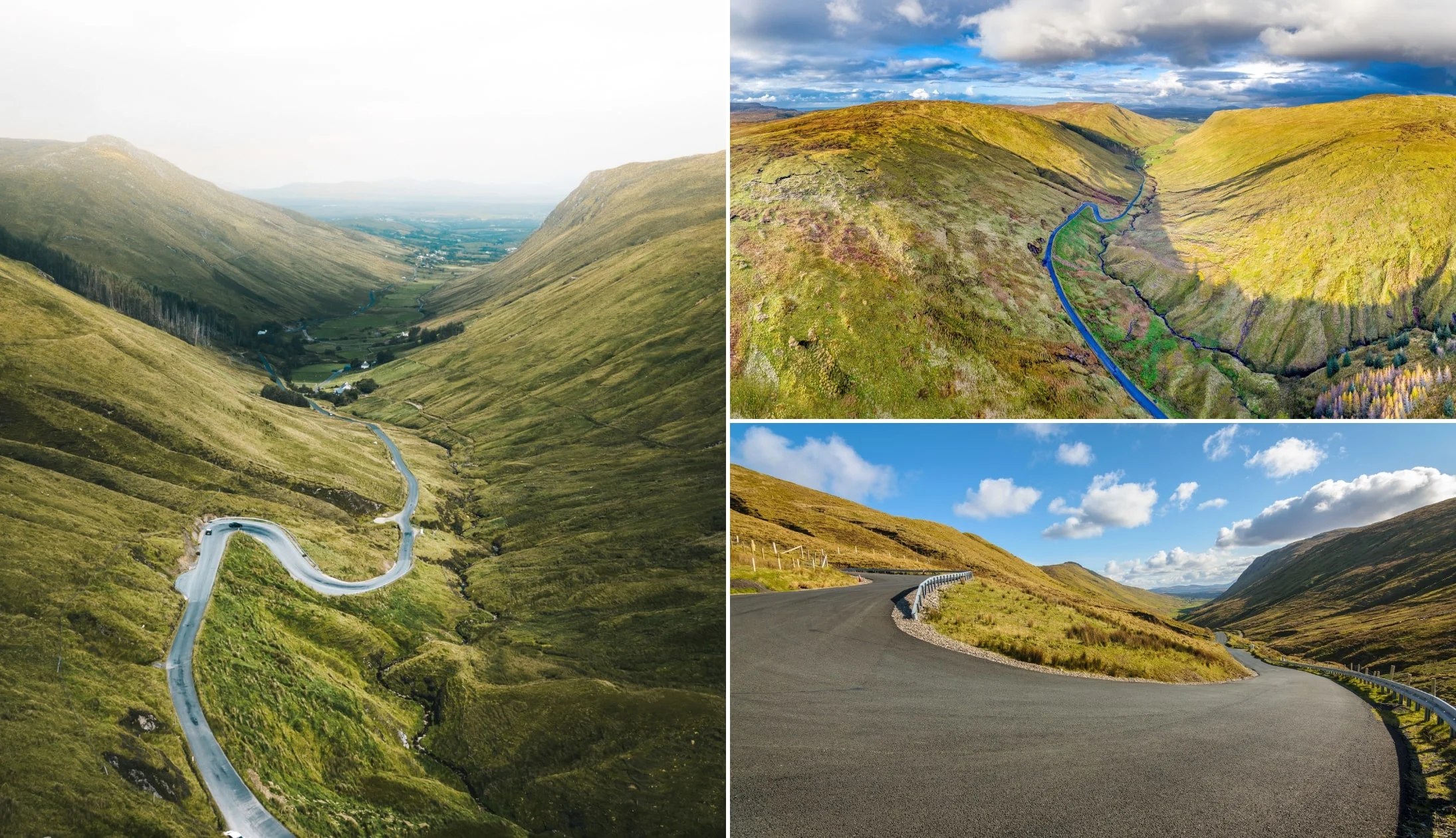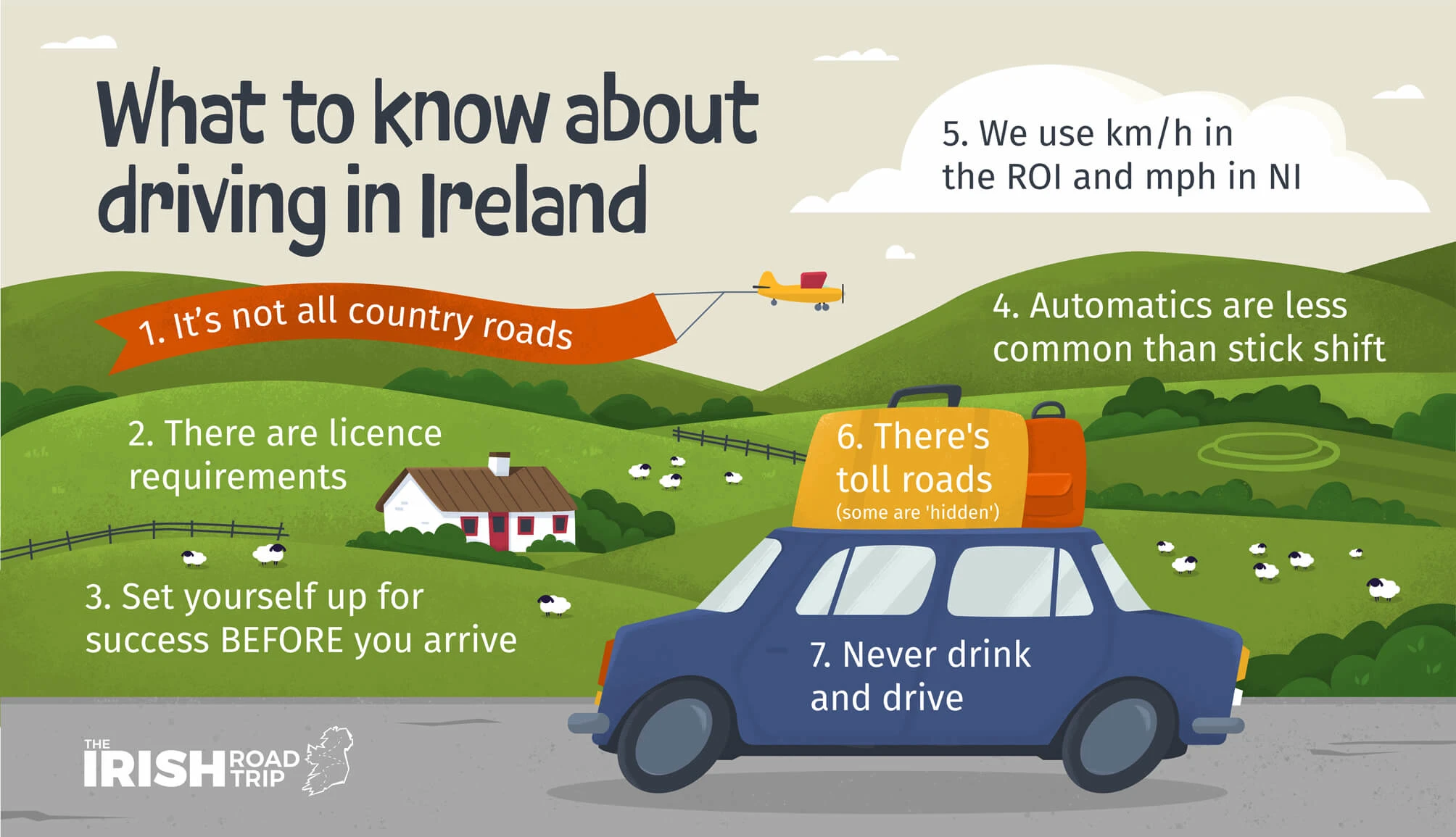Is driving in Ireland as a tourist difficult? Yes! However, if you, like thousands other visitors to Ireland, use this guide, you’ll find yourself confident and capable!
The main mistake tourists make when driving in Ireland for the first time is they do zero prep. The result? A lack of confidence and potentially dangerous situations.
The solution? Preparation both before your trip and when you arrive. Follow these quick 5 steps and you’ll set yourself up for success when driving in Ireland:
- Step 1: The key info: (e.g. we drive on the left hand side in Ireland)
- Step 2: Legal requirements (there are different driving in Ireland requirements)
- Step 3: Pre-visit prep (anticipate things that may cause stress, e.g. how to use a roundabout)
- Step 4: In-car competence (understanding key functions, e.g. defogging the window)
- Step 5: On-road confidence (where you use a quieter road to build you confidence)
Below, you’ll find handy tips on how to drive in Ireland as an American, Australian or European. Enjoy!
Step 1: Key info to get you up-to-speed on driving in Ireland
Many people spend heaps of time planning a trip to Ireland, and in particular getting their head around the mess that is renting a car in Ireland.
However, they never take time to prep for driving in Ireland as a tourist visiting for the first time. Here is some info to get you up-to-speed fast:
1. We drive on the left
Cars in Ireland drive on the left hand side of the road.
2. It’s not all narrow country roads
Some websites would lead you to believe that driving in Ireland as a tourist means learning to get to grips with narrow roads with grass up the centre of them. These roads exist, but the condition of roads in many parts of Ireland is excellent.
3. Both km/h and mp/h are used
There are differences between Ireland and Northern Ireland when it comes to how speed is measured. In the 26 counties of the Republic of Ireland km/h is used while in the 6 counties of Northern Ireland mp/h is used.
4. Stick shift/automatic can be hard to get
Manual/stick shift, vehicles are more common in Ireland than automatics. Unfortunately, many people who plan on driving in Ireland for the first time fail to specify that they want an automatic when renting a car, and end up with a manual transmission instead.
5. Toll roads
There are 1 toll roads in the Republic of Ireland. 10 are the standard tool-both-style (i.e. pay with cash/card). However, 1, the M50 Toll, is a ‘free-flowing system’ that reads your number plate. You then pay in specific stores or online.
6. Drink driving
Never drink and drive. The drink-driving limit in Ireland is a BAC of 50mg (it’s 20mg for learner and novice drivers). For most people, 1 standard drink = a BAC of 20 – 50mg.
Step 2: The driving in Ireland requirements

Photos via Shutterstock
One of the most overlooked tips for driving in Ireland for the first time is to check if you can legally drive here in the first place.
The two main things you need to check are the licence requirements and the insurance requirements for driving in Ireland.
1. Licence requirements for Americans
Driving in Ireland with US license is allowed for a visit of up to 12 months. Staying for over 12 months? You’ll need to apply for an International Permit.
2. Licence requirements for EU/EEA member states
Drivers from an EU/EEA member state (e.g. France, Germany, Belgium, etc.) are able to drive in Ireland for as long as their licence is valid.
3. Licence requirements for non-EU/EEA residents
The driving in Ireland requirements for no-EU/EEA/recognised states is straightforward – residents can drive with a valid national driving licence for up to 12 months.
4. Insurance requirements
You need to have insurance, either in your name or as a named driver, to legally drive in Ireland. If you’re renting a car in Ireland, a basic level of insurance is included in the rental cost by law.
Step 3: Anticipate what elements of driving in Ireland may cause stress in advance
I get asked is it easy to drive in Ireland very regularly – the answer? Yes, once you take time to prepare in advance.
One of the most useful driving in Ireland tips is to take some time to think about what may cause you stress and prepare in advance.
There tends to be 4 different areas that make driving in Ireland for the first time tricky, like:
1. Driving on the left
I talk to a lot of Americans driving in Ireland and this tends to be the thing they most worry about. We drive on the left-hand side of the road in Ireland.
Now, for the most part, this should be fine. The problem is often remembering it, especially when you’re getting back into the car. Turning up your left sleeve or repeating ‘Left is best’ can hammer it into your brain.
2. Roundabouts, intersections and ‘right of way’
Roundabouts are generally one that cause people issues when driving in Ireland as a tourist, especially as there is often plenty of traffic around you.
Hit play on the video above to see what you need to do. Intersections/junctions can cause similar issues. The key thing to remember is right of way.
If you’re joining a road, the traffic in either direction on that road has the right of way and you must wait for it to clear. At a crossroad or roundabout, the traffic to your right has right of way, unless signage says otherwise.
3. Prepare for road signs
If you’re following one of our Ireland itinerary guides, you’ll encounter hundreds of road signs within minutes of driving in Ireland for the first time.
It’s imperative that you familiarise yourself with these in advance from Ireland’s Road Safety Authority.
4. Narrow roads
The next of our driving in Ireland trips revolves around those often-romanticised country roads. You meet them when you step off-the-beaten-path. If you’re used to narrow roads, you’ll have no problem.
If you want to avoid these kind of roads (e.g. the ones on the Dingle Peninsula), plan your route out and use Google Satellite and Street View to gauge which roads may cause you issues and plan around them.
Step 4: When you arrive get used to the cars key functions

Photos via Shutterstock
Step four is for those renting a car and driving in Ireland for the first time. If you’re bringing your own car, you can skip this step.
When you pick-up your car rental in Ireland, sit inside and make sure you understand how to use each of the following:
- Mirrors (adjust prior to setting off)
- Indicators
- Headlights
- How to de-fog the windows
- Window wipers
- Hazard lights
- Fog lights
Step 5: Get use to driving in Ireland on quieter roads first
One of the better tips for driving in Ireland as a tourist is to set yourself up for success from the moment you leave the car rental spot.
The way to do this is to find a shortish route that allows you to get used to the car, driving on the left etc. Let’s use leaving Dublin Airport as an example.
Option 1: The M1/M50 motorways
If you look at the map above, you’ll see Dublin Airport. You’ll also see a red dotted line that shows the busy M50/M1 Motorways where speed limits hit 120 km/h in places.
If you’re not driving in Ireland for the first time, these will be no bother to you. If you are, choose option 2.
Option 2: A quieter route
I’ve outlined this route on Google Maps as an example of a route you could use to get used to driving in Ireland as a tourist on their first visit.
It follows straightforward roads, avoids any crazy roundabouts and it ends in a big car park where you can stop and plan your next steps.
Although this example is for Dublin Airport, you can easily map one out if you’re visiting Shannon, Belfast etc.
Ireland driving rules to be aware of

There are key rules of the road that you need to be familiar with when learning how to drive in Ireland.
There’s also many road signs that can cause confusion if you’re driving in Ireland as a tourist for the first time.
Note: This is not an exhaustive guide on how to drive in Ireland – care, the ability to drive properly and preparation are all required.
1. Speed limits
Generally, there are 5 different types of speed limits in both the Republic of Ireland and Northern Ireland and they vary from 50 km/h (30 mph) in built-up areas to 100km/h on some motorways.
You’ll see the speed limits listed clearly on road signs while your drive around Ireland, so pay attention.
2. Changing lanes
If you need to change lanes, care must be taken. Keep an eye on the road signs so that you have plenty of time to move over and remember “mirror, signal, mirror, manoeuvre”.
First, check your mirrors to ensure your way is clear. Next, indicate your intent. Check your mirrors once more to ensure your lane is still clear, and if so, begin to move into the next lane.
3. Overtaking
When driving on a dual carriageway or motorway, you’re required by law to remain in the left-hand lane unless you’re safely overtaking another vehicle.
Check twice and indicate, before moving over. Once you’ve overtaken, repeat the process to return to the left-hand lane.
Stick to the speed limit as you overtake and look out for signs/markings indicating that overtaking is forbidden.
4. U-turns
U-turns are typically prohibited unless traffic conditions make the manoeuvre completely safe. On some roads, U-turns will still be prohibited even if conditions are safe.
Other roads that prohibit U-turns tend to be marked by either an upright sign or a continuous white line in the centre of the road.
5. Slowing down or stopping on a road
Occasionally you may find you need to pull over or slow down. Only do so if it’s safe and you can be sure you won’t block the road.
Before you begin to slow down, check your mirrors and then signal your intent by using your indicators or hazard lights and begin to slow down.
6. Driving at night
If you’re nervous and driving in Ireland for the first time, we’d recommend that you avoid driving in the dark until you’re confident.
When driving at night, ensure your windscreen and lights are clean (the weather in Ireland can play havoc on a cars condition!).
Headlights must be on when driving at night. Avoid high beams when driving in built-up areas, when there’s oncoming traffic, or if you’re driving behind someone.
7. Seat belts must be worn
By law, anyone driving in Ireland along with all passengers must wear seat belts whenever the vehicle is in motion.
In Ireland, it’s the driver’s responsibility to ensure that all passengers are wearing their seat belts.
The only exception is for children under 150 cm (around 5 ft) tall and less than 36 kg (around 80 pounds) – they must use a suitable child restraint system.
8. Never use a phone
Regardless of whether your driving the Ring of Kerry or spinning along the Antrim Coast, NEVER use a hand-held phone while driving. This applies when you’re in stationary traffic too.
9. In case of an emergency
The Gardaí have a good breakdown on what to do for a variety of emergency types.
It’s also worth checking with your rental company to see what to do in the event of a minor incident (e.g. if the car won’t start).
Driving in Ireland as an American

Photos via Shutterstock
We get emails asking about how to drive in Ireland as an American every couple of days without fail.
As it stands, United States citizens can can go about driving in Ireland for up to 12 months as a tourist. If you want to get an international permit, you can do so via the AAA in the US.
If you’re an American driving in Ireland for the first time and you’re worried, relax. Once you follow the tips mentioned above you’ll set yourself up for success.
If you’re looking to follow a logical, straigtforward road trip itinerary but don’t want to do the research/planning, see our free self guided driving tours of Ireland.
FAQs about driving in Ireland for the first time
Since we started publishing Irish Road Trip itineraries many years ago, one of the most common queries we get relates to driving in Ireland as a tourist.
Below, we’ve attempted to answer the most FAQs, but if you have one you’d like to ask, shout in the comment section.
What side of the road do they drive on in Ireland?
Cars in Ireland drive on the left hand side of the road. This can take some getting used to for those used to driving on the right.
Can Americans drive in Ireland with a US license?
Americans can drive in Ireland with a US license for up to 1 year. Do note, however, that any stay over 12 months will require an international permit.
Is driving in Ireland difficult?
Driving in Ireland for the first time can be intimidating. Whether it’s difficult is completely person dependant. With proper preparation and planning, most will find driving here fine.
Keith O’Hara has lived in Ireland for 35 years and has spent most of the last 10 creating what is now The Irish Road Trip guide. Over the years, the website has published thousands of meticulously researched Ireland travel guides, welcoming 30 million+ visitors along the way. In 2022, the Irish Road Trip team published the world’s largest collection of Irish Road Trip itineraries. Keith lives in Dublin with his dog Toby and finds writing in the 3rd person minus craic altogether.



Sagry
Tuesday 21st of February 2023
I really apreciate your excelent work , I will travel to Ireland next summer and all the information you provided is a great help for me . Thank you so much, will be reading it for a while, I,m sure i,ll found many important and interesting piece of advice .
Great job Keith Sagry from Madrid in Spain
Anita
Sunday 11th of December 2022
We learned a lesson the hard way when we rented a car in Ireland. Make sure you check what type of gas goes into the car. The Hertz rental people didn't tell us and there was no sticker by the gas tank to indicate what type of gas the car used. My husband put in regular gas and turned out, the car used diesel. Needless to say, the car started running horribly and we had to have someone called by Hertz come out to drain the gas lines...when we returned the car at Shannon airport, the dummy light was still lit up on the dashboard and we had to pay an extra 800 euro because of this. I tried fighting the charge with Hertz to no avail.
Lisa
Saturday 15th of October 2022
Hi Keith, thanks for the great information! I'll be taking a road trip this November. I'm worried about right of way on smaller roads that aren't one-way. Do you just pull over to let the other driver pass? I'm not sure if I will encounter a lot of roads like this, but I have seen pictures of the roads. The road looks too small to fit more than one car. Thanks, Lisa
Tom Walker
Wednesday 27th of July 2022
Great advice, I rent about 60 cars a year on business here in the US. I never move my car until I understand how to operate the Wipers, Defroster, Lights, Shifter and Mirrors. I like the idea of finding a place to practice driving on the left side of the road prior to departing the agency.
Well done!
Brendan Flood
Monday 18th of July 2022
Hey, Keith. I have something I cannot find any information on is whether it's legal to turn at a red light. In the US, where I am, it is legal to turn right on red in some states but not others. Is the equivalent, turning left on red, legal in Ireland? Is it any different in Northern Ireland? Thanks.
Keith O'Hara
Tuesday 19th of July 2022
Hey Brendan - In Ireland you need to wait for a green light to turn and it's the same in NI. Have a lovely trip!